Abstract
Controlled drainage (CD) is one of the basic techniques used to manage groundwater levels. Farmers can optimize water levels for crop growth at different stages of the growing season. Proper drainage water management can reduce the risk of soil erosion and surface water pollution. By controlling drainage, sediment and nutrient runoff can be minimized, leading to improved water quality in nearby streams and rivers. A mixed methods approach was used, which was based on the bibliometric analysis and content analysis of 462 articles using the bibliometrix R package and VOSviewer software. The article aimed to analyze the Author Keywords and KeyWords Plus to indicate the resulting clusters of complex interdependence that emerge from the main research areas. Continuous research continues to improve drainage techniques and systems to optimize agricultural water use. The results indicated the importance of researching the feasibility of CD for agriculture. The innovation of this study is that it points out the relevance of taking up the possibility of changing the use of unilateral subsurface drainage systems with another method of controlling drainage outflows as a current global challenge, contributing to filling this gap in the literature.
1. Introduction
Climate change, population growth, and economic development will contribute to many challenges already being faced by water management in agricultural areas of the world [1]. The report by the World Bank [2] finds that the most severe impact of a changing climate would be the effect on water supplies. Agriculture is an important sector in the world; agriculture requires water, whose water needs must be supplied in a context of scarce resources. Contemporary water management for agriculture is related not only to traditional water resources management but also to food production, rural development, and natural resources management [3,4].
For a long time, most civilizations have focused on building more or less sophisticated water management systems based on drainage systems [5]. Stormwater management is a challenge exacerbated by urban and agricultural development. Solutions are being sought to capture, store and redistribute water for both urban life and large-scale agriculture. However, in both urban and rural environments, inadequate stormwater management can lead to flooding, erosion and the deterioration of aquatic habitats [6]. New challenges are emerging for urban land adaptation to anticipated climate change in the use of green infrastructure at small and large scales [7,8]. Harvesting and reusing rainwater and providing water to meet agricultural and domestic needs is becoming important [9,10]. According to Lintern et al. [11], 60% of studies found improvements in water quality after the implementation of Best Management Practices (BMPs) within the urban and agricultural watersheds.
In addition, the International Commission for Irrigation and Drainage (ICID) [12] notes that improving irrigation and drainage systems in agricultural areas will play a key role in achieving water and food security in conditions of adaptation to climate change, especially in developing countries. There will be more and more studies suggesting that irrigation and drainage technologies have an important role to play in adapting to climate change [13,14]. As defined by the ICID, drainage is “the removal of excess surface or groundwater from any area, naturally or by virtue of man-made surface or subsurface conduits,” and it “has four main functions: creating well drained arable lands, preventing salinization of the soils, lowering of groundwater table and removal of accumulated salts or toxic elements” [15]. The artificial drainage can change hydrology, because it is a major conduit for substantially increases in nitrate, phosphorus and other soluble nutrients that leach into water through the soil profile [16]. This type of artificial subsurface drainage is called free drainage (FD) or conventional drainage. Subsurface drainage systems have been widely adopted in many countries, particularly in regions where water management and soil conditions are crucial for successful agriculture. The percentage of agricultural land using subsurface drainage can vary significantly depending on factors such as climate, soil type, agricultural practices, and government policies [17]. Around 1500 million hectares are cultivated worldwide, of which an estimated 40% require improved drainage. However, the true extent of agricultural drainage is unknown; some estimates suggest that around one-third of the land in need of improvement or system change ought to implement artificial drainage [18,19].
The possibility of using drainage systems, including subsurface systems, as a method of drainage for areas with the problem of waterlogging and/or salinity and achieving the sustainability of irrigated agriculture has been around since ancient times. Agricultural water management is the interactions related to irrigation and drainage, which are generally important requirements in hydrological processes and water movement in the soil [20]. For many years, the current strategies to save water and increase water productivity have only been focusing on improving irrigation performance, disregarding the drainage needs. During this time, scientific activities were conducted to develop new drainage materials and installation methods in an effective and environmentally friendly, which can be used in the future. Agricultural subsurface drainage plays an important role in crop production in temperate and humid climates. New guidelines for the design of drainage systems that take into account both crop production results and the growing awareness of environmental protection, including surface water, are being researched [21]. Subsurface drainage will be part of the solution to future global food and water demand as well as water security [5].
In the 1940s and 1950s, the United States began implementing a CD, and other countries began to gradually conduct research with the possibility of applying this solution to them. In this way, the agricultural conservation practice of drainage water management (DWM) has become operational, which allows stile outlet elevations to be managed. The use of a simple structure in which controls such as weir boards can be added and removed cause subsurface drainage to be restricted or promoted by lifting and lowering the tile outlet elevations. It allows changing the functioning of the drainage system throughout the year, lowering the drain so that water can drain freely during field operations. Then, it raises the water table after planting to increase water available for use of crops during the growing season. Afterwards, it raises the water table again after harvest to limit drainage outflow during the non-growing season [22]. This practice of groundwater management allows changing the levels of these waters in agricultural fields. The technique uses an existing or newly designed drainage network and a water control structure or device in the drainage well to limit the flow of water from the drain outlet. The impact on the change of the hydrological cycle of the field depends on temporal and spatial scale and the dates of planned treatments during the year. The CD technique allows increasing some or all of the flow components such as water storage in the root zone, shallow and deep seepage, surface runoff, plant uptake and evaporation [23].
Many studies have documented the impact of DWM as a practice that can reduce losses of water and nutrients such as nitrogen (N) and phosphorus (P) from tile drainage, and they also consider subsequent changes in surface runoff across a range of geographic regions [24,25,26,27,28,29,30,31]. Sands et al. [32] measured an annual drainage reduction of 20% over a six-year study in south–central Minnesota. Fausey [24] indicated that CD flow volume was approximately 60% of the FD flow volume. Ramoska et al. [26] conducted research in parts of central Lithuania and showed that in the CD system, the amount of annual drainage outflow was reduced by 25%, and nitrate leaching was 20–28% lower compared to FD. Strock et al. [33] indicated an average reduction in subsurface drainage volume of 40% based on a review of 15 peer-reviewed studies. However, Gunn et al. [34] showed that control effectively reduced daily subsurface drainage volume by 40% to 100% depending on location. Research on CD indicates the following possibilities: reducing the volume of drainage water, adjusting groundwater levels, improving water availability and delaying the onset of water stress on crops while saving water [29,35,36]. We can find field studies where both measured and modeled data are used to evaluate the impact of CD on the quantity and quality of water in subsurface runoff and tile discharge from plots, fields, or small catchment areas [37,38]. Sunohara et al. [39] indicated reductions in outflow and reductions in nitrate and total phosphorus of 60 and 58% as a result of CD in eastern Ontario, Canada. In contrast, other studies show reductions in drainage outflow and N loading ranging from 18% to 80% [27,34,40,41]. Helmers et al. [28] showed that using CD or shallow drainage reduced the total drainage volume by 37% and 46%, respectively. In addition, the average annual NO3-N losses were found to be reduced by 36% and 29% with CD and shallow drainage, respectively. Youssef et al. [42] used modeling in their studies, which were conducted over a 25-year period using the DRAINMOD and DRAINMOD-NII models in the US Midwest. The simulation results showed that CD reduced annual subsurface drainage and N loss by an average of 30% and 32%, respectively. In contrast, Valero et al. [43] showed that higher groundwater levels increase the mobilization of phosphorus from the soil profile. Other studies have shown an increase in nutrient-laden surface runoff [44,45,46]. However, Wesström and Messing [25] showed decreases in N and P loading that were the same as the reduction in drain outflow rate (60–95%). In the 21st century, researchers have undertaken research in new topics on best management practices, in which smart drainage, automated drainage, and sustainable drainage have been considered to address the challenges regarding climate change and environmental issues [5]. An example of developing technology is the combination of controlled drainage and irrigation (CDS), drainage water recycling, allowing for improved water quality in agriculture and an increased productivity of crop production [47].
To identify research progress and trends related to CD, this study conducted a bibliometric analysis for the years 2000–2022. At present, publications on CD have been concentrated on field and/or model studies indicating the results obtained in quantitative or qualitative terms. There is a lack of publications indicating the trend of researchers’ attention to visualize the development history and evolution process of CD use in response to climate change affecting agriculture.
2. Materials and Methods
There are three different methodological phases, the first stage being the collection of literature data. A systematic literature review is conducted using an advanced search, using the following keyword sets in the Web of Science (WoS) Core Collection: Science Citation Index Expanded (SCI-EXPANDED). Scientific articles published in English were found based on abstracts, titles, and keywords published (i.e., TS field tag, search string ((‘control* drainage’ OR ‘control* tile drainage’ OR ‘drainage water management’ OR ‘groundwater management’) AND (‘agricultural drainage’ OR ‘subsurface drainage’ OR ‘water quality’))) between 1 January 2000 and 31 December 2022. The present bibliometric study is an analysis of the current state-of-the-art of the most relevant research papers on CD (Figure 1).
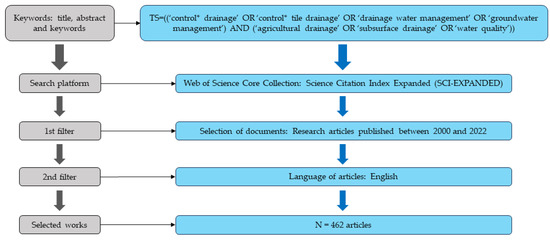
Figure 1.
Proceedings and criteria established to make the bibliometric analysis about CD in a global level. N = total number.
The second stage is bibliometric analysis based on the selected data corpus. The research method used to evaluate publications was bibliometric analysis on trends of CD. The analysis used research techniques such as evolution of the number and citations of scientific articles published, the most important journals and publishers, highly cited papers, Meso and Micro Citation Topics, the network between titles, sources and keywords, wordcloud, the most local cited authors, authors’ production over time, and corresponding author’s countries. The analysis involved determining co-occurrences in two keyword categories based on a .txt file and used VOSviewer software 1.6.18 [48,49]. We set the threshold representing the minimum number of occurrences to 15 and 20 for Author Keywords and KeyWords Plus, respectively. The relevance score was calculated, and 15 of 1253 and 26 of 1152 relevant terms were selected for Author Keywords and Keywords Plus, respectively. The first type is Author Keywords, those provided by the original authors, and second is KeyWords Plus, those extracted from the titles of the cited references by Thomson Reuters. KeyWords Plus terms have been used to identify research trends in a variety of scientific fields. They are words or phrases generated by an automated computer algorithm that often appear in article reference titles, including those not found in the article title or as author keywords [50,51]. Descriptive statistics and regression analysis were performed and presented in the form of histograms and graphs. Microsoft Office Excel version 365 tools were used for these analyses as well as the specialized bibliometrix and biblioshiny R-package [52].
The final third step is to evaluate the content analysis of selected publications in order to consolidate the previous conclusions and identify issues and research topics relevant to CD; a content analysis of selected WOS publications was conducted. Based on the VOSviewer clusters and related items obtained from the bibliometric analysis, the correlation of occurring keywords from the past five years was determined.
3. Results
3.1. Bibliometric Analysis
An exponential increase in articles published on the subject is shown in the regression analysis during 23 years (Figure 2). As shown, there is a growing trend of scientific publications, highlighting the importance of the application of CD practice on agricultural land in terms of the quantitative and qualitative withholding of drainage outflows to the scientific community. In the last five years (2018–2022), 193 articles were published, representing 42% of the total. Figure 2 shows that the average number of citations per article gradually increased from 2000 to 2015 and then reached an average level of 670 articles for two years. From 2018 to 2022, a significant increase in citations is observed from a level of 851 to 1780.
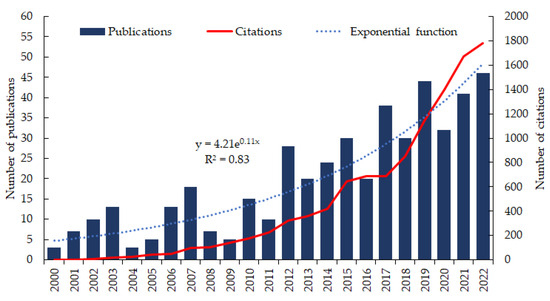
Figure 2.
Exponential growth of the number and citations of articles published on the subject worldwide over the last two decades (2000–2022).
Among the peer-reviewed journals, 105 published equally five or fewer articles on the topic. The majority of peer-reviewed articles came from 19 peer-reviewed journals with 59.96% (Table 1). As shown, the highest number (top five) of publications related to CD research are in Agricultural Water Management, Hydrogeology Journal, Journal of Environmental Quality, Environmental Earth Sciences and Science of the Total Environment journals.

Table 1.
Relevant published journals according to the number of records by WOS.
As shown in Figure 3, the order of publishers whose journals account for the majority of published articles is as follows: Elsevier, followed by Springer and WILEY (with a combined share of 64%). Moreover, 6% of the articles were published by MDPI, 5% were published by the American Society of Agricultural and Biological Engineers, 4% were published by the Soil and Water Conservation Society, 3% were published by the American Society of Agronomy and only 2% were published by Taylor & Francis, American Geophysical Union and International Water Association Publications.

Figure 3.
A listing of the leading publishers and the number of papers per publisher. * Other publishers, representing 41, where the number of articles is equal to or less than 5.
Citation analysis identifies the articles most frequently cited by researchers or scholars who are interested in citing that article in the field. It is based on the number of citations of all articles downloaded from the WoS database to identify those that contributed the most. In Table 2, the articles have been ranked based on the number of citations; the average number of citations per year is also indicated to determine the impact of time since publication of the cited papers.

Table 2.
List of highly cited papers in the database ranked by the total number of citations.
WoS allows the indication of research areas; 462 articles were assigned to the following three main Meso-Citation Topics (80%): 38% represent Soil Science, 6% are in the category Climate Change, and Water Resources represent 36% of the total. In the first category (Figure 4), three groups of Micro-Citation Topics were identified, the largest being those on Nitrous Oxide with 112 articles accounting for 24% of the total. In the other two categories, the most important micro topics are Water Governance (5%) and Groundwater (31%), respectively.
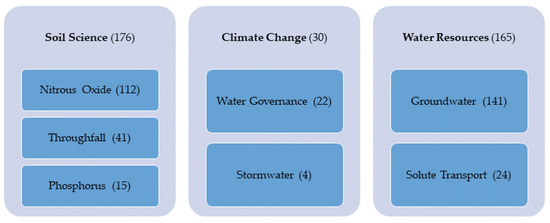
Figure 4.
Visualizing with selected top three Meso- and Micro-Citation Topics of articles count from WoS.
Figure 5 showed a three-field plot based on a Sankey diagram that depicts the connections from sources to titles and keywords. The height of the rectangle nodes is proportional to the frequency of occurrence of a certain source, title, or keyword within the collaboration network. The width of the lines between the nodes is proportional to the number of connections. The figure shows that ‘groundwater’ (frequency = 152) was the word in titles with the most connections, which was followed by ‘drainage’ (frequency = 145) and ‘water’ (frequency = 125). The top contributing source with ‘groundwater’ was Environmental Earth Sciences (21/152 = 13.8%), which was followed by Hydrogeology Journal (14/152 = 9.2%). With ‘drainage’, the top contributing source was Agricultural Water Management (46/145 = 31.7%), followed by the Journal of Soil and Water Conservation (17/145 = 11.7%). As for the keywords on the right, the most common words in titles contributing to the prevalence of ‘controlled drainage’ were ‘drainage’ (34.9%) and ‘water’ (21.8%). In addition, the top words in titles associated with ‘groundwater management’ were ‘groundwater’ (38.9%) and ‘management’ (18.5%).
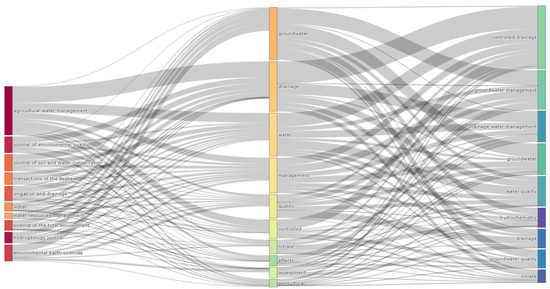
Figure 5.
A three-field plot showing the network between sources (left), title (middle), and keywords (right) of articles on CD from 2000 to 2022.
Figure 6 illustrates the word cloud of frequently occurring titles in research studies. A bigger word size and bold font emphasize the frequency and strength of sources (Figure 6). The word cloud represents visually the most frequent words used in relevant titles and abstracts of studies and helps identify the more important ones. The most dominant words in titles were groundwater (n = 196), drainage (n = 162), water (n = 133), management (n = 128), quality (n = 85), controlled (n = 60), assessment (n = 43), nitrate (n = 40), agricultural (n = 38), and effects (n = 36). However, the most frequent words in abstracts were water (n = 1672), groundwater (n = 1490), drainage (n = 1262), management (n = 712), quality (n = 675), study (n = 508), model (n = 405), controlled (n = 356), results (n = 322), and soil (n = 304).

Figure 6.
Wordcloud with the most important words found in: (a) title; (b) abstract.
According to data about the most local cited authors, Youssef M.A. and Skaggs R.W. were the top two with 162 and 141 citations, respectively (Figure 7). The individuals mentioned were related to the faculty of the North Carolina State University Department of Biological and Agricultural Engineering. These researchers have made significant contributions to the advancement of agricultural and biological engineering and are worldwide experts in drainage and subsurface water management. Skaggs created DRAINMOD, which is a model that effectively predicts the performance of drainage and related water management systems. Skaggs with Youseff and colleagues extended the model’s capabilities to predict the movement and fate of nitrates, salts, and other solutes in the soil profile. Additionally, they used the model to evaluate and assess the hydrology of wetlands and recently to predict soil carbon, nitrogen dynamics, and plant growth in drained forests and agricultural ecosystems.
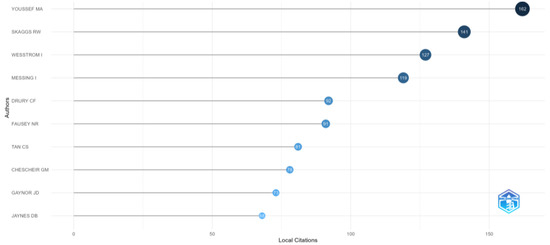
Figure 7.
The most local cited authors in the list of publications.
Figure 8 shows the performance of the top 10 authors over the past 22 years. The circle shows the number of articles, varying in size; the more articles, the larger the circle. The color represents the total number of citations per year; the darker the color, the higher the number of citations. Youseff (North Carolina State University Department of Biological and Agricultural Engineering, USA) has been the most productive author since 2006 and continues to be, with a high number of citations in 2009, 2012, 2018 and 2020 and the highest number of published articles (18). The most productive author in 2015 was Fausey (United States Department of Agriculture, Soil Drainage Research Unit; 5 articles; total citations per year 62.22).
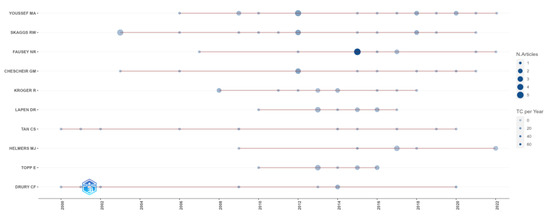
Figure 8.
The top 10 authors’ research output over the past 22 years.
Figure 9 presents the ranking of the top 20 corresponding author’s countries. The USA had the highest total citations of 4.648, China had 1.899 and Canada had 966. In terms of publications, the USA led (n = 153), which was followed by China (n = 56) and Canada (n = 43). All in all, Figure 9 shows that these three countries were three leading countries in terms of total citations, number of publications, frequency of publications, single country publications (SCPs), and multiple country publications (MCPs).
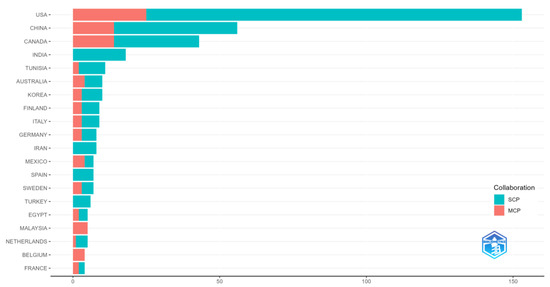
Figure 9.
Corresponding author’s countries number of publications.
3.2. Content Analysis
3.2.1. Author Keyword
Table 3 presents a list of items with their number of occurrences and associated clustering groups. Based on the Author Keywords analysis, four clusters were identified. A co-occurrence network map of terms was created based on the WOS data provided to VOSviewer. The map shows 15 relevant terms linked by co-occurrence links. Each term on the map had a color indicating clusters of more closely related terms.

Table 3.
Items with number of occurrences in brackets for each cluster calculated by VOSviewer for the Author Keywords analysis unit.
Based on this network, the four visualized clusters were labeled with the following four names referring to possible research topics:
- Cluster 1—Groundwater management (red);
- Cluster 2—Model-based research (green);
- Cluster 3—Field research (blue);
- Cluster 4—Drainage water quality (yellow).
The clusters were named by authors. The highest ranking of 70 occurrences was given to the phrase “controlled drainage” found in cluster 2 (Figure 10). Cluster 2 was named “Model Research,” suggesting the importance of this phrase in reflections describing the interrelationship between field research and model research relating to water management on a drainage site through CD practice. Cluster 1 includes terms that co-occur in publications treating groundwater management as a resource of value to agricultural areas. The second most recurring element is ‘groundwater’ in Cluster 1, indicating the important role of groundwater availability for crops in agricultural areas. Anomalies that alter unsustainable water management are increasingly common. Cluster 2 includes the co-occurrence of the terms ‘controlled drainage’, ‘subsurface drainage’ and ‘drainmod’. They appear to refer to modeling studies to determine the applicability of CD practice under different temporal and spatial conditions. The DRAINMOD model is a tool used to predict changes in the water balance of drained agricultural land under different agricultural drainage systems, fields, weather conditions and management practices. Cluster 3 seems to relate to the transformative aspects of DWM in agricultural areas. As such, it represents field research on the positive and negative effects of subsurface drainage design, management and maintenance. The keyword that appears most often is ‘drainage water management’, which is probably referring to the emphasis on the importance of exploring new techniques for using existing or designed drainage networks to hold back drainage water outflow. The last cluster relates to the quality of drainage water; withholding drainage outflow helps reduce the amount of nutrient loads carried off from agricultural land into nearby surface waters. This is indicated by the most common keywords ‘drainage’, ‘nitrogen’ and ‘phosphorus’.

Figure 10.
Map of co-occurrence terms with the four clusters for the Author Keywords analysis unit.
Figure 11 confirms the author’s most frequent keywords, occurring with a frequency above 15. The figure additionally shows other terms, including up to 25 keywords.
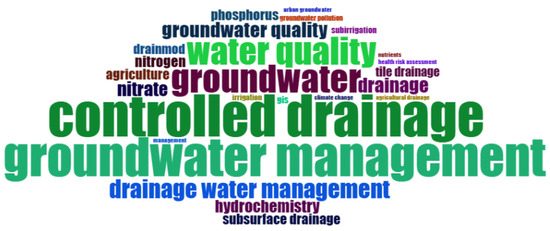
Figure 11.
Word cloud for the Author Keywords analysis unit.
Figure 12 shows that the entire classification structure forms a tree dendrogram, displaying the close association between the author keywords in the field of CD. Also distinguished are four thematic groups, the first of which focuses on groundwater management in different areas. The second group includes words related to modeling the application of CD practice in qualitative aspects on agricultural land. How does the applied practice alone or with another, such as subirrigation, affect the ability to control outflow on a drainage facility? The last group consists of the largest number of keywords relating to the search for new methods within subsurface drainage with respect to withholding drainage runoff and the amount of nutrients.
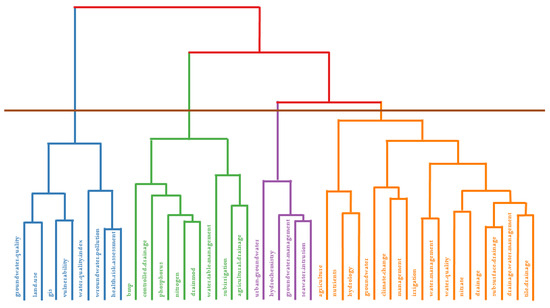
Figure 12.
Dendrogram of hierarchical cluster analysis of Author Keywords in the field of CD.
3.2.2. KeyWords Plus
Based on an analysis of the KeyWords Plus, three cluster groups were identified (see Table 4). The first was marked in red with the most frequent word ‘water quality’, the second was marked in green with the most frequent word ‘subsurface drainage’, and the last was marked in blue with the most frequent word ‘transportation’.

Table 4.
Items with number of occurrences in brackets for each cluster calculated by VOSviewer for the KeyWords Plus analysis unit.
Figure 13 shows the results of the KeyWord Plus clusters in different colors. In the middle of this graph are three words, one from each cluster, and they form a strong connection between the clusters. These are the following words: ‘water quality’ from the red cluster and ‘quality’ and ‘nitrate’ from the green and blue groups, respectively.
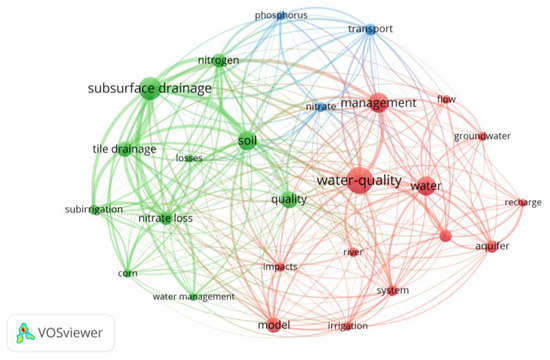
Figure 13.
Map of co-occurrence terms with the three clusters for the KeyWords Plus analysis unit.
The most important KeyWords Plus terms are shown in Figure 14.
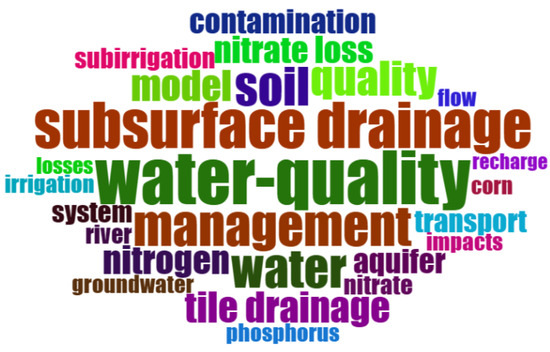
Figure 14.
Word cloud for the KeyWords Plus analysis unit.
Figure 15 shows the four thematic groups highlighted. The largest group is made up of terms highlighted in purple indicating the use of controlled drainage as a technique to influence the quantity and quality of water draining from agricultural land. The resulting group underscores the complexity of the subject of CD application in agricultural areas whose drainage water drains into nearby surface water. This is indicated by the diverse words found in this group: ‘controlled drainage’, ‘river’, ‘water quality’, and ‘basin’.
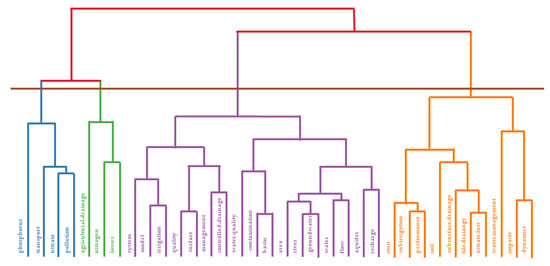
Figure 15.
Tree dendrogram of hierarchical cluster analysis of KeyWords Plus in the field of CD.
4. Discussion
The performed bibliometric analysis indicated the multidisciplinary aspect of the researched issue, resulting from the cluster division of keywords used in individual articles. There has been increasing interest in artificial subsurface drainage as a basis for changing unilateral drainage action. CD allows controlling and increasing the level of groundwater available during the growing season, which is required for sustainable agricultural production in many parts of the world [62,63]. Based on the results, the use of CD has received considerable attention as a potential BMP to improve water quality in tile-drained landscapes in the USA. Most studies are evaluating the effects of DWM on subsurface outflow as well as on N and P loads in drainage water [29,37].
Field studies have been conducted by a number of researchers to determine the effect of CD on N losses depending on soil properties, drainage system intensity, drainage control strategy and location. N losses in drainage water have been reduced by about the same percentage as subsurface drainage outflows in most cases [25,64]. Field data and modeling with DRAINMOD conducted by Skaggs et al. [23,44] and Luo et al. [65] showed that the model with calibrated input data can accurately predict daily changes in GWT and daily drainage outflows. The simulation study provides an indication of how CD can reduce annual drainage outflow and nitrogen losses while affecting yields, depending on the input data. Also, research is being conducted to determine the effectiveness of CD with subsurface irrigation to reduce nitrate losses from the crop field and increase yields [66].
In order to facilitate and support decision making for policy makers and farmers, this article aims to explore what the future of subsurface drainage is and what will happen in the future, including what solutions can be applied. The following effect was obtained using a mixed method based on a systematic literature review and subsequent bibliometric analysis. Of these articles, more than 53% were published after 2015. That is when Agenda 2030 was signed, and since then, there has been a significant increase in the work of scientists to explore new opportunities to take adaptation actions to find solutions to climate change, and special attention has been given to the role of the agricultural sector.
This study aims to fill the literature gap regarding the different used methods of DWM policy implementation, since most of the previous studies have a field or modeling approach. The review indicated that interests in changing the unilateral operation of drainage systems through various techniques for controlling drainage runoff are being explored by the scientific community. However, it is the farmers and the institutions that advise them that have a key role in managing drainage systems. In particular, they can promote new and multidisciplinary strategies for managing drainage and irrigation systems through the integration of different actors. Thus, investment in innovation that gives the specific tools and technologies needed to confront climate change is important. Therefore, scientists and agricultural policy institutions should help farmers adopt technological innovations by providing financial support and fostering knowledge exchange.
5. Conclusions
In recent years, a great deal of attention has been given in the literature and in many policy documents to the application of various groundwater management techniques on agricultural lands as adaptation measures to the projected effects of climate change [67]. This article aims to explore how the CD technique is applied in field and model studies; the result was achieved by using a mixed method. Based on the Web of Science database, the literature in the field of CD from 2000 to 2022 was retrieved, and VOSviewer, bibliometrix and biblioshiny software packages were used for data mining and analysis. From the perspective of publication trend, the document number on CD continues to grow; especially after 2016, the document number increased. From the perspective of paper citation, the strongest development period of research is since the year 2017. The increase in published articles was noted after 2015, when Agenda 2030 was signed, drawing attention to finding solutions for the agricultural sector with techniques for withholding or reusing agricultural drainage water. There is growing awareness that nutrient losses from agricultural fields to surface water can be effectively reduced with mitigation measures targeting drainage water.
In general, attention paid to CD research and scholars participating in this study have been gradually increasing over time. In terms of research power in the field, developed countries from Europe and the United States are more influential. China, a developing country, also plays an important role in the field of land degradation as a major agricultural country. The most frequent Author Keywords in the field of CD are groundwater management, controlled drainage, drainage water management, and drainage. The bibliometric analysis exposed the multidisciplinary nature of the investigated issue, emerging from the cluster division of the works. Papers were allocated in three and four clusters, sometimes overlapping. Clusters of greater importance relate to the application of CD in terms of withholding outflows and nutrients, which was followed by potential adaptations to climate change and the introduction of other solutions to reuse drainage water.
The idea of this article was to analyze the application of the change in the use of subsurface drainage systems using the CD technique from 2000 to 2022 in relation to climate change and agriculture from the perspective of the global challenge. The main limitation of this study is that different researchers may have chosen other keywords that they pointed out in the publication of the study that were consistent with their scientific field.
Author Contributions
Conceptualization, B.K., R.S., M.K. and A.C.; methodology, B.K.; software, B.K.; formal analysis, B.K.; investigation, B.K.; writing—original draft preparation, B.K.; writing—review and editing, R.S., M.K. and A.C.; visualization, B.K.; project administration, A.C.; funding acquisition, A.C. All authors have read and agreed to the published version of the manuscript.
Funding
This research was conducted within the research project no. 2022/47/D/HS4/01313 funded by the National Science Centre of Poland (A.C.).
Data Availability Statement
All relevant data and codes generated by the authors or analyzed during the study are within the paper.
Acknowledgments
The authors acknowledge the developers of all the software/tools used in the analyses.
Conflicts of Interest
The authors declare no conflict of interest.
References
- Easterling, D.R.; Meehl, G.A.; Parmesan, C.; Changnon, S.A.; Karl, T.R.; Mearns, L.O. Climate Extremes: Observations, Modeling, and Impacts. Science 2019, 289, 2068–2074. [Google Scholar] [CrossRef] [PubMed]
- World Bank Group. High and Dry: Climate Change, Water, and the Economy; World Bank: Washington, DC, USA, 2016; Available online: http://hdl.handle.net/10986/23665 (accessed on 15 April 2023).
- Nissan, H.; Goddard, L.; de Perez, E.C.; Furlow, J.; Baethgen, W.; Thomson, M.C.; Mason, S.J. On the use and misuse of climate change projections in international development. Wiley Interdiscip. Rev. Clim. Change 2019, 10, e579. [Google Scholar] [CrossRef]
- Malhi, G.S.; Kaur, M.; Kaushik, P. Impact of Climate Change on Agriculture and Its Mitigation Strategies: A Review. Sustainability 2021, 13, 1318. [Google Scholar] [CrossRef]
- Valipour, M.; Krasilnikof, J.; Yannopoulos, S.; Kumar, R.; Deng, J.; Roccaro, P.; Mays, L.; Grismer, M.E.; Angelakis, A.N. The Evolution of Agricultural Drainage from the Earliest Times to the Present. Sustainability 2020, 12, 416. [Google Scholar] [CrossRef]
- Finkenbine, J.K.; Atwater, J.W.; Mavinic, D.S. Stream health after urbanization 1. JAWRA J. Am. Water Resour. Assoc. 2000, 36, 1149–1160. [Google Scholar] [CrossRef]
- Zellner, M.; Massey, D.; Minor, E.; Gonzalez-Meler, M. Exploring the effects of green infrastructure placement on neighborhood-level flooding via spatially explicit simulations. Comput. Environ. Urban Syst. 2016, 59, 116–128. [Google Scholar] [CrossRef]
- Ahiablame, L.; Shakya, R. Modeling flood reduction effects of low impact development at a watershed scale. J. Environ. Manag. 2016, 171, 81–91. [Google Scholar] [CrossRef]
- Walsh, T.C.; Pomeroy, C.A.; Burian, S.J. Hydrologic modeling analysis of a passive, residential rainwater harvesting program in an urbanized, semi-arid watershed. J. Hydrol. 2014, 508, 240–253. [Google Scholar] [CrossRef]
- Deitch, M.J.; Feirer, S.T. Cumulative impacts of residential rainwater harvesting on stormwater discharge through a peri-urban drainage network. J. Environ. Manag. 2019, 243, 127–136. [Google Scholar] [CrossRef] [PubMed]
- Lintern, A.; McPhillips, L.; Winfrey, B.; Duncan, J.; Grady, C. Best management practices for diffuse nutrient pollution: Wicked problems across urban and agricultural watersheds. Environ. Sci. Technol. 2020, 54, 9159–9174. [Google Scholar] [CrossRef]
- ICID. Report of the 22nd International Congress on Irrigation and Drainage. Securing Water and Food and Rural Community under Climate Change; ICID: Gwangju, Republic of Korea, 2014; Available online: https://www.icid.org/22Cong_Report_final.pdf (accessed on 20 March 2020).
- Rosenzweig, C.; Strzepek, K.M.; Major, D.C.; Iglesias, A.; Yates, D.N.; McCluskey, A.; Hillel, D. Water resources for agriculture in a changing climate: International case studies. Glob. Environ. Change 2004, 14, 345–360. [Google Scholar] [CrossRef]
- Nelson, G.C.; Rosegrant, M.W.; Koo, J.; Robertson, R.; Sulser, T.; Zhu, T.; Ringler, C.; Msangi, S.; Palazzo, A.; Batka, M.; et al. Costs of Agriculture Adaptation to Climate Change; Discussion Paper No. 4; World Bank: Washington, DC, USA, 2010; Available online: https://documents1.worldbank.org/curated/en/973551468165538882/pdf/566620NWP0D1CC10Box353730B01PUBLIC1.pdf (accessed on 15 April 2023).
- ICID. Available online: https://www.icid.org/res_drainage.html (accessed on 20 March 2020).
- David, M.B.; Drinkwater, L.E.; McIsaac, G.F. Sources of nitrate yields in the Mississippi River Basin. J. Environ. Qual. 2010, 39, 1657–1667. [Google Scholar] [CrossRef]
- Yannopoulos, S.I.; Grismer, M.E.; Bali, K.M.; Angelakis, A.N. Evolution of the Materials and Methods Used for Subsurface Drainage of Agricultural Lands from Antiquity to the Present. Water 2020, 12, 1767. [Google Scholar] [CrossRef]
- Smedema, L.K.; Abdel-Dayem, S.; Ochs, W.J. Drainage and agricultural development. Irrig. Drain. Syst. 2000, 14, 223–235. [Google Scholar] [CrossRef]
- Smedema, L.K. Nine International Drainage Workshops: History, objectives, content and reflections on significance and impacts. Irrig. Drain. 2007, 56, S23–S34. [Google Scholar] [CrossRef]
- Ritzema, H.P. Drain for Gain: Managing salinity in irrigated lands—A review. Agric. Water Manag. 2016, 176, 18–28. [Google Scholar] [CrossRef]
- Ghane, E.; Askar, M.H.; Skaggs, R.W. Design drainage rates to optimize crop production for subsurface-drained fields. Agric. Water Manag. 2021, 257, 107045. [Google Scholar] [CrossRef]
- Frankenberger, J.; Kladviko, E.; Sands, G.; Jaynes, D.; Fausey, N.; Helmers, M.; Cooke, R.; Strock, J.; Nelson, K.; Brown, L. Drainage water management for the Midwest: Questions and answers about drainage water management for the Midwest. Purdue Ext. 2006, 1–8. Available online: https://www.extension.purdue.edu/extmedia/WQ/WQ-44.pdf (accessed on 20 March 2020).
- Skaggs, R.W.; Youssef, M.A.; Chescheir, G.M. DRAINMOD: Model Use, Calibration, and Validation. Trans. ASABE 2012, 55, 1509–1522. [Google Scholar] [CrossRef]
- Fausey, N.R. Drainage management for humid regions. Int. Agric. Eng. J. 2005, 14, 209–214. Available online: https://blancharddemofarms.org/wp-content/uploads/2021/06/DrainageWater-6.pdf (accessed on 15 April 2023).
- Wesström, I.; Messing, I. Effects of controlled drainage on N and P losses and N dynamics in a loamy sand with spring crops. Agric. Water Manag. 2007, 87, 229–240. [Google Scholar] [CrossRef]
- Ramoška, E.; Bastiene, N.; Saulys, V. Evaluation of controlled drainage efficiency in Lithuania. Irrig. Drain. 2011, 60, 196–206. [Google Scholar] [CrossRef]
- Cooke, R.; Verma, S. Performance of drainage water management systems in Illinois, United States. J. Soil Water Conserv. 2012, 67, 453–464. [Google Scholar] [CrossRef]
- Helmers, M.; Christianson, R.; Brenneman, G.; Lockett, D.; Pederson, C. Water table, drainage, and yield response to drainage water management in southeast Iowa. J. Soil Water Conserv. 2012, 67, 495–501. [Google Scholar] [CrossRef]
- Williams, M.R.; King, K.W.; Fausey, N.R. Drainage water management effects on tile discharge and water quality. Agric. Water Manag. 2015, 148, 43–51. [Google Scholar] [CrossRef]
- Ritzema, H.P.; Stuyt, L.C.P.M. Land drainage strategies to cope with climate change in the Netherlands. Acta Agric. Scand. Sect. B—Soil Plant Sci. 2015, 65, 80–92. [Google Scholar] [CrossRef]
- Carstensen, M.V.; Børgesen, C.D.; Ovesen, N.B.; Poulsen, J.R.; Hvid, S.K.; Kronvang, B. Controlled Drainage as a Targeted Mitigation Measure for Nitrogen and Phosphorus. J. Environ. Qual. 2019, 48, 677–685. [Google Scholar] [CrossRef] [PubMed]
- Sands, G.R.; Song, I.; Busman, L.M.; Hansen, B.J. The effects of subsurface drainage depth and intensity on nitrate loads in the northern cornbelt. Trans. ASABE 2008, 51, 937–946. [Google Scholar] [CrossRef]
- Strock, J.S.; Sands, G.R.; Helmers, M.J. Subsurface drainage design and management to meet agronomic and environmental goals. In Soil Management: Building a Stable Base for Agriculture; Hatfield, J.L., Sauer, T.J., Eds.; American Society of Agronomy and Soil Science Society of America: Madison, WI, USA, 2011. [Google Scholar] [CrossRef]
- Gunn, K.M.; Fausey, N.R.; Shang, Y.; Shedekar, V.S.; Ghane, E.; Wahl, M.D.; Brown, L.C. Subsurface drainage volume reduction with drainage water management: Case studies in Ohio, USA. Agric. Water Manag. 2015, 149, 131–142. [Google Scholar] [CrossRef]
- Tolomio, M.; Borin, M. Controlled drainage and crop production in a long-term experiment in North-Eastern Italy. Agric. Water Manag. 2019, 222, 21–29. [Google Scholar] [CrossRef]
- Dou, X.; Shi, H.; Li, R.; Miao, Q.; Yan, J.; Tian, F.; Wang, B. Simulation and evaluation of soil water and salt transport under controlled subsurface drainage using HYDRUS-2D model. Agric. Water Manag. 2022, 273, 107899. [Google Scholar] [CrossRef]
- Skaggs, R.W.; Chescheir, G.M. Effects of subsurface drain depth on nitrogen losses from drained lands. Trans. Am. Soc. Agric. Eng. 2003, 46, 237–244. [Google Scholar] [CrossRef]
- Lahdou, G.B.; Bowling, L.; Frankenberger, J.; Kladivko, E. Hydrologic controls of controlled and free draining subsurface drainage systems. Agri. Water Manag. 2019, 213, 605–615. [Google Scholar] [CrossRef]
- Sunohara, M.D.; Gottschall, N.; Craiovan, E.; Wilkes, G.; Topp, E.; Frey, S.K.; Lapen, D.R. Controlling tile drainage during the growing season in Eastern Canada to reduce nitrogen, phosphorus, and bacteria loading to surface water. Agric. Water Manag. 2016, 178, 159–170. [Google Scholar] [CrossRef]
- Adeuya, R.; Utt, N.; Frankenberger, J.; Bowling, L.; Kladivko, E.; Brouder, S.; Carter, B. Impacts of drainage water management on subsurface drain flow, nitrate concentration, and nitrate loads in Indiana. J. Soil Water Conserv. 2012, 67, 474–484. [Google Scholar] [CrossRef]
- Jaynes, D.B. Changes in yield and nitrate losses from using drainage water management in central Iowa, United States. J. Soil Water Conserv. 2012, 67, 485–494. [Google Scholar] [CrossRef]
- Youssef, M.A.; Abdelbaki, A.M.; Negm, L.M.; Skaggs, R.W.; Thorp, K.R.; Jaynes, D.B. DRAINMOD-simulated performance of controlled drainage across the US Midwest. Agric. Water Manag. 2018, 197, 54–66. [Google Scholar] [CrossRef]
- Valero, C.S.; Madramootoo, C.A.; Stämpfli, N. Water table management impacts on phosphorus loads in tile drainage. Agric. Water Manag. 2007, 89, 71–80. [Google Scholar] [CrossRef]
- Skaggs, R.W.; Youssef, M.A.; Gilliam, J.W.; Evans, R.O. Effect of controlled drainage on water and nitrogen balances in drained lands. Trans. ASABE 2010, 53, 1843–1850. [Google Scholar] [CrossRef]
- Tan, C.S.; Zhang, T.Q. Surface runoff and subsurface drainage phosphorus losses under regular free drainage and controlled drainage with sub-irrigation systems in southern Ontario. Can. J. Soil Sci. 2011, 91, 349–359. [Google Scholar] [CrossRef]
- Coelho, B.B.; Murray, R.; Lapen, D.; Topp, E.; Bruin, A. Phosphorus and sediment loading to surface waters from liquid swine manure application under different drainage and tillage practices. Agric. Water Manag. 2012, 104, 51–61. [Google Scholar] [CrossRef]
- Ng, H.Y.F.; Tan, C.S.; Drury, C.F.; Gaynor, J.D. Controlled drainage and subirrigation influences tile nitrate loss and corn yields in a sandy loam soil in Southwestern Ontario. Agric. Ecosyst. Environ. 2002, 90, 81–88. [Google Scholar] [CrossRef]
- Van Eck, N.J.; Waltman, L. How to normalize cooccurrence data? An analysis of some well-known similarity measures. J. Am. Soc. Inf. Sci. Technol. 2009, 60, 1635–1651. [Google Scholar] [CrossRef]
- Van Eck, N.J.; Waltman, L. VOSviewer Manual, Manual for VOSviewer version 1.6.18; University of Leiden: Leiden, The Netherlands, 2022; pp. 1–53. Available online: https://www.vosviewer.com/documentation/Manual_VOSviewer_1.6.18.pdf (accessed on 8 July 2022).
- Garfield, E. KeyWords Plus: ISI’s breakthrough retrieval method. Part 1. Expanding your searching power on current contents on diskette. Curr. Contents 1990, 32, 5–9. [Google Scholar]
- Garfield, E.; Sher, I.H. Keywords PlusTM algorithmic derivative indexing. J. Am. Soc. Inf. Sci. 1993, 44, 298. [Google Scholar] [CrossRef]
- Aria, M.; Cuccurullo, C. bibliometrix: An R-tool for comprehensive science mapping analysis. J. Informetr. 2017, 11, 959–975. [Google Scholar] [CrossRef]
- Bouwer, H. Artificial recharge of groundwater: Hydrogeology and engineering. Hydrogeol. J. 2002, 10, 121–142. [Google Scholar] [CrossRef]
- Changming, l.; Jingjie, Y.; Kendy, E. Groundwater Exploitation and Its Impact on the Environment in the North China Plain. Water Int. 2001, 26, 265–272. [Google Scholar] [CrossRef]
- Custodio, E. Aquifer overexploitation: What does it mean? Hydrogeol. J. 2002, 10, 254–277. [Google Scholar] [CrossRef]
- King, K.W.; Williams, M.R.; Macrae, M.L.; Fausey, N.R.; Frankenberger, J.; Smith, D.R.; Kleinman, P.J.A.; Brown, L.C. Phosphorus transport in agricultural subsurface drainage: A review. J. Environ. Qual. 2015, 44, 467–485. [Google Scholar] [CrossRef]
- Li, P.; Wu, J.; Qian, H.; Lyu, X.; Liu, H. Origin and assessment of groundwater pollution and associated health risk: A case study in an industrial park, northwest China. Environ. Geochem. Health 2014, 36, 693–712. [Google Scholar] [CrossRef]
- Wu, J.; Zhou, H.; He, S.; Zhang, Y. Comprehensive understanding of groundwater quality for domestic and agricultural purposes in terms of health risks in a coal mine area of the Ordos basin, north of the Chinese Loess Plateau. Environ. Earth Sci. 2019, 78, 446. [Google Scholar] [CrossRef]
- Li, P.; He, S.; Yang, N.; Xiang, G. Groundwater quality assessment for domestic and agricultural purposes in Yan’an City, northwest China: Implications to sustainable groundwater quality management on the Loess Plateau. Environ. Earth Sci. 2018, 77, 775. [Google Scholar] [CrossRef]
- Ledoux, E.; Gomez, E.; Monget, J.M.; Viavattene, C.; Viennot, P.; Ducharne, A.; Benoit, M.; Mignolet, C.; Schott, C.; Mary, B. Agriculture and groundwater nitrate contamination in the Seine basin. The STICS–MODCOU modelling chain. Sci. Total Environ. 2007, 375, 33–47. [Google Scholar] [CrossRef]
- Wu, J.; Zhang, Y.; Zhou, H. Groundwater chemistry and groundwater quality index incorporating health risk weighting in Dingbian County, Ordos basin of northwest China. Geochemistry 2020, 80, 125607. [Google Scholar] [CrossRef]
- Strock, J.S.; Kleinman, P.J.A.; King, K.W.; Delgado, J.A. Drainage water management for water quality protection. J. Soil Water Conserv. 2010, 65, 131A–136A. [Google Scholar] [CrossRef]
- Thorp, K.R.; Jaynes, D.B.; Malone, R.W. Simulating the long-term performance of drainage water management across the Midwestern United States. Trans. ASABE 2008, 51, 961–976. [Google Scholar] [CrossRef]
- Wesström, I.; Messing, I.; Linner, H.; Lindström, J. Controlled drainage—Effects on drain outflow and water quality. Agric. Water Manag. 2001, 47, 85–100. [Google Scholar] [CrossRef]
- Luo, W.; Sands, G.R.; Youssef, M.; Strock, J.S.; Song, I.; Canelon, D. Modeling the impact of alternative drainage practices in the northern Corn-belt with DRAINMOD-NII. Agric. Water Manag. 2010, 97, 389–398. [Google Scholar] [CrossRef]
- Drury, C.F.; Tan, C.S.; Reynolds, W.D.; Welacky, T.W.; Oloya, T.O.; Gaynor, J.D. Managing tile drainage, subirrigation, and nitrogen fertilization to enhance crop yields and reduce nitrate loss. J. Environ. Qual. 2009, 38, 1193–1204. [Google Scholar] [CrossRef]
- Castellano, M.J.; Archontoulis, S.V.; Helmers, M.J.; Poffenbarger, H.J.; Six, J. Sustainable intensification of agricultural drainage. Nat. Sustain. 2019, 2, 914–921. [Google Scholar] [CrossRef]
Disclaimer/Publisher’s Note: The statements, opinions and data contained in all publications are solely those of the individual author(s) and contributor(s) and not of MDPI and/or the editor(s). MDPI and/or the editor(s) disclaim responsibility for any injury to people or property resulting from any ideas, methods, instructions or products referred to in the content. |
© 2023 by the authors. Licensee MDPI, Basel, Switzerland. This article is an open access article distributed under the terms and conditions of the Creative Commons Attribution (CC BY) license (https://creativecommons.org/licenses/by/4.0/).